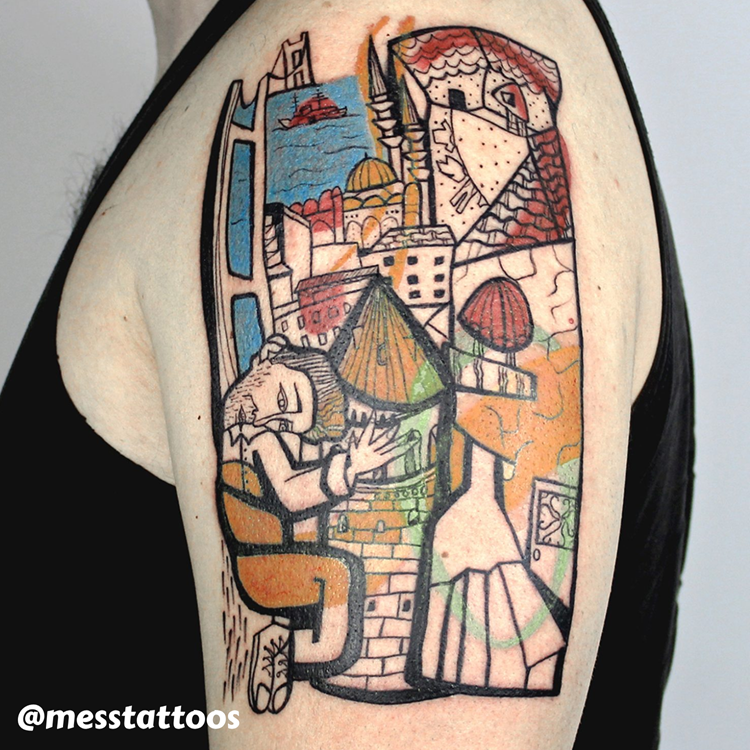Expressionism, as a tattoo style, is rooted in the broader art movement of the same name, which emerged in the early 20th century. Originally developed as a reaction against realism and naturalism, Expressionism sought to convey emotional experiences rather than physical reality. In tattoo art, this ethos translates into designs that prioritize emotional intensity, boldness, and personal expression over strict realism or technical perfection.

Origins in Fine Art
Expressionism as an art movement began in Europe, particularly in Germany, around 1905 with groups such as Die Brücke (The Bridge) and Der Blaue Reiter (The Blue Rider). Artists like Edvard Munch, Wassily Kandinsky, and Egon Schiele explored themes of emotional turmoil, existential angst, and spiritual awakening. They used bold, exaggerated lines, distorted forms, and vibrant, often clashing colors to evoke intense emotions. The movement influenced literature, theater, and film, in addition to visual arts, leaving a legacy of bold innovation and a focus on subjective experience.
Transition to Tattoo Art
Expressionism began influencing tattooing in the late 20th and early 21st centuries as tattoo artists increasingly drew inspiration from fine art movements. The style became a way for individuals to channel intense personal narratives and emotions into their tattoos.
- Visual Characteristics:
- Distortion and Exaggeration: Tattoos in this style often feature distorted anatomy, faces, or abstracted figures to convey a sense of raw emotion.
- Bold Lines and Brushstroke Effects: These tattoos mimic the dynamic, rough brushstrokes of Expressionist paintings, creating a hand-painted look.
- Vivid Colors and High Contrast: The use of bright, clashing colors, often layered in chaotic yet deliberate ways, creates visual drama.
- Emotional Focus: Themes often explore existential questions, inner turmoil, or abstract concepts like love, fear, and hope.
- Key Influences:
- The works of Expressionist painters like Munch’s The Scream or Schiele’s raw figurative sketches have been directly adapted into tattoo art.
- German Expressionist cinema, with its dramatic lighting and angular designs (e.g., The Cabinet of Dr. Caligari), has also inspired tattoo compositions.

Development as a Tattoo Style
Expressionism as a tattoo style gained momentum alongside other fine-art-inspired tattoo movements, such as neo-traditional and watercolor tattooing. It appealed to both tattoo artists and clients who sought to break free from the confines of hyper-realism or traditional styles and wanted tattoos that felt deeply personal and artistic.
- Early Pioneers: Tattoo artists like Amanda Wachob, David Cote, and others were among the first to adapt painterly styles into tattooing, laying the groundwork for Expressionist-inspired tattoos.
- Technological Advances: The development of high-quality tattoo inks and machines allowed artists to experiment with dynamic color blending, gradients, and textures resembling brushstrokes and impasto techniques.

Modern Expressionism Tattoos
Today, Expressionism in tattoo art continues to evolve, with some key features:
- Abstract Portraiture: Faces and figures are rendered in fragmented or exaggerated ways, often expressing sadness, joy, or existential struggle.
- Painterly Techniques: Tattoos mimic oil or acrylic painting, incorporating textures that resemble smeared paint or chaotic lines.
- Symbolic Imagery: Artists may include symbolic motifs, such as distorted flowers, animals, or surrealist landscapes, to add layers of meaning.
- Personal Narratives: The emphasis is often on deeply personal stories or emotions, making each tattoo a unique reflection of the client’s psyche.
Cultural Impact
Expressionism tattoos have carved a niche in contemporary body art, appealing to those who see tattoos as more than decorative but as visceral, meaningful artworks. By drawing on the raw emotional power of the Expressionist art movement, these tattoos blur the line between fine art and skin art, offering a profoundly moving medium of self-expression.